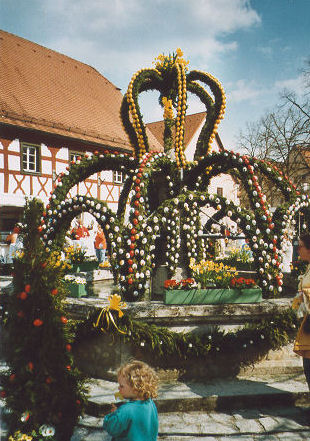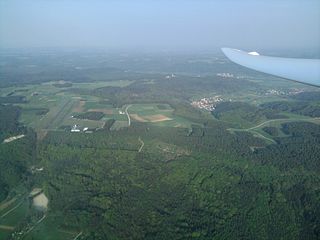
Fürth is a city in northern Bavaria, Germany, in the administrative division (Regierungsbezirk) of Middle Franconia.

The Schenk von Stauffenberg family is a Roman Catholic Uradel German noble family from Swabia, Germany. The family's best-known recent member was Colonel Claus Schenk Graf von Stauffenberg – the key figure in the 1944 "20 July plot" to assassinate Adolf Hitler.

Kronach is a town in Upper Franconia, Germany, located in the Franconian Forest area. It is the capital of the district Kronach.

Franconian Switzerland is an upland in Upper Franconia, Bavaria, Germany and a popular tourist retreat. Located between the River Pegnitz in the east and the south, the River Regnitz in the west and the River Main in the north, its relief, which reaches 600 metres in height, forms the northern part of the Franconian Jura (Frankenjura). Like several other mountainous landscapes in the German-speaking lands, e.g. Holstein Switzerland, Märkische Schweiz, or Pommersche Schweiz, Franconian Switzerland was given its name by Romantic artists and poets in the 19th century who compared the landscape to Switzerland. Franconian Switzerland is famous for its high density of traditional breweries.

Königsfeld is a community located in the Upper Franconian district of the Bamberg in Bavaria, and a member of the administrative community (Verwaltungsgemeinschaft) of Steinfeld.

Feuchtwangen is a city in Ansbach district in the administrative region of Middle Franconia in Bavaria, Germany with around 12,000 citizens and 137km² of landmass making it the biggest city in the Ansbach district by Population and Landmass. In the year 2019 Feuchtwangen celebrated its 1200th jubilee based on the first mention of its Benedictine monastery.

Hirschaid is a German market town in the Upper Franconian district of Bamberg and lies roughly twelve kilometres south of Bamberg on the Regnitz and the Main-Danube Canal.

Burgkunstadt is a town in the district of Lichtenfels, in northern Bavaria, Germany. It is situated on the right bank of the Main, 15 km west of Kulmbach, and 24 km southeast of Coburg.

Ebermannstadt is a town in the district of Forchheim, in Bavaria, Germany. It is situated 10 km northeast of Forchheim and 25 km southeast of Bamberg.

Hallstadt is a town in the Upper Franconian district of Bamberg on the left bank of the Main, 4 km north of Bamberg.

Scheßlitz is a German town in the Upper Franconian district of Bamberg and lies on the rise to the Franconian Switzerland on the A 70 between Bamberg and Bayreuth, lying 14 km northeast of the former.

Breitengüßbach is a community in the Upper Franconian district of Bamberg in Bavaria. It was first mentioned as Gusibach and as belonging to the royal court at Hallstadt in an Imperial document issued between 812 and 830.

Buttenheim is a market town in the Upper Franconian district of Bamberg and lies in the Regnitz Valley between Bamberg and Nuremberg, Germany.

Stadelhofen is a municipality in the Upper Franconian district of Bamberg and a member of the administrative community (Verwaltungsgemeinschaft) of Steinfeld.
Dreuschendorf is a small village located in Bavaria, Germany. It is in Upper Franconia, in the Bamberg district. Dreuschendorf is a constituent community of Buttenheim.

The Osterbrunnen is a German tradition of decorating public wells or fountains with Easter eggs for Easter. It began in the early 20th century in the Franconian Switzerland region of Upper Franconia but has spread to other regions. The decoration is usually kept from Good Friday until two weeks after Easter.

Waischenfeld Castle is a ruined rock castle on a rocky plateau a few metres west of the town of Waischenfeld in the province of Upper Franconia in the German state of Bavaria.

The burgstall of Wolkenstein Castle is the site of a late medieval aristocratic castle in the village of Wolkenstein, in the borough of Ebermannstadt in the county of Forchheim in the German state of Bavaria. The burgstall is in private hands and may not be visited.

The Lange Meile is a plateau in the Franconian Jura in south Germany which is up to about 517 m above sea level (NHN). It lies within the region of Franconian Switzerland in the Upper Franconian county of Forchheim in the state of Bavaria.































































































